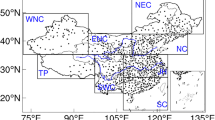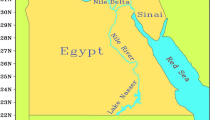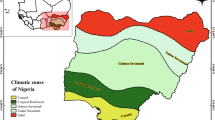Abstract
Heat waves (HWs) can have disastrous impacts on human activities and natural systems, and are one of the current foci of scientific research, particularly in the context of global warming. However, there is no standard definition of a HW, which makes assessment of temporal trends a challenge. In this study, based on daily mean, maximum and minimum temperature, and relative humidity datasets from China Meteorological Administration, the patterns, trends and variations of HW in China during 1961–2014 are investigated. Sixteen previously published HW indices (HIs) are calculated, which are divided into two types using relative and absolute threshold temperatures, respectively. During 1961–2014, both relative and absolute threshold HIs show the highest number of HW in Jianghua and South China, geographically consistent with the climate characteristics of China. The majority of HIs shows negative/positive trends of HW days before/after 1990 over the whole of China, but especially in Jianghua and South China, which reflects rapid warming since 1990. There are significant correlations among different HIs in the same type (both absolute and relative), but correlations are weak between relative and absolute threshold HIs. Because relative and absolute HIs show contrasting trends, the choice of HI is therefore critical for future analysis










Similar content being viewed by others
References
Amengual A, Homar V, Romero R, Brooks H, Ramis C, Gordaliza M, Alonso S (2014) Projections of heat waves with high impact on human health in Europe. Global Planet Change 119:71–84
Anderson G, Bell ML (2011) Heat waves in the United States: mortality risk during heat waves and effect modification by heat wave characteristics in 43 U.S. communities. Environ Health Perspect 119(2):210–218
Barriopedro D, Fischer EM, Luterbacher J, Trigo RM, García-Herrera R (2011) The hot summer of 2010: redrawing the temperature record map of Europe. Science 332(6026):220–224
Bumbaco KA, Dello KD, Bond NA (2013) History of Pacific Northwest heat waves: synoptic pattern and trends. J Appl Meteorol Climatol 52(7):1618–1631. doi:10.1175/jamc-d-12-094.1
Carril AF, Gualdi S, Cherchi A, Navarra A (2007) Heatwaves in Europe: areas of homogeneous variability and links with the regional to large-scale atmospheric and SSTs anomalies. Clim Dyn 30(1):77–98. doi:10.1007/s00382-007-0274-5
Chen M, Geng FH, Ma LM, Zhou WD (2013) Analyses on the heat wave events in Shanghai in Recent 138 years. Plateau Meteorol 32(2):597–607 (in Chinese)
Cowan T, Purich A, Perkins S, Pezza A, Boschat G, Sadler K (2014) More frequent, longer, and hotter heat waves for Australia in the twenty-first century. J Clim 27(15):5851–5871. doi:10.1175/JCLI-D-14-00092.1
Della-Marta PM, Luterbacher J, Weissenfluh H, Xoplaki E, Brunet M, Wanner H (2007) Summer heat waves over western Europe 1880–2003, their relationship to large-scale forcings and predictability. Clim Dyn 29(2):251–275. doi:10.1007/s00382-007-0233-1
Fischer EM (2014) Autopsy of two mega-heatwaves. Nat Geosci 7:332–333
Fischer EM, Schär C (2010) Consistent geographical patterns of changes in high-impact European heatwaves. Nat Geosci 3(6):398–403
Habeeb D, Vargo J, Stone B (2015) Rising heat wave trends in large US cities. Nat Hazards 76(3):1651–1665. doi:10.1007/s11069-014-1563-z
Hamed KH, Rao AR (1998) A modified Mann–Kendall trend test for autocorrelated data. J Hydrol 204:182–196
IPCC (2013) Summary for policymakers of climate change 2013: the physical science basis. Contribution of working group I to the fifth assessment report of the intergovernmental panel on climate change. Cambridge University Press, Cambridge
Joshi MK, Pandey AC (2011) Trend and spectral analysis of rainfall over India. J Geophys Res Atmos 116:D06104
Kyselý J (2010) Recent severe heat waves in central Europe: how to view them in a long-term prospect? Int J Climatol 30(1):89–109. doi:10.1002/joc.1874
Lewis SC, Karoly DJ (2013) Anthropogenic contributions to Australia’s record summer temperatures of 2013. Geophys Res Lett 40(14):3705–3709. doi:10.1002/grl.50673
Li QX, Dong WJ (2009) Detection and adjustment of undocumented discontinuities in Chinese temperature series using a composite approach. Adv Atmos Sci 26(1):143–153. doi:10.1007/s00376-009-0143-8
Li QX, Liu XN, Zhang HZ, Peterson TC, Easterling DR (2004) Detecting and adjusting temporal inhomogeneity in Chinese mean surface air temperature data. Adv Atmos Sci 21(2):260–268
Li QX, Huang J, Jiang Z, Zhou L, Chu P, Hu K (2014) Detection of urbanization signals in extreme winter minimum temperature changes over Northern China. Clim Change 122(4):595–608. doi:10.1007/s10584-013-1013-z
Lu R-Y, Chen R-D (2016) A review of recent studies on extreme heat in China. Atmos Ocean Sci Lett 9(2):114–121
Lyon B (2009) Southern Africa summer drought and heat waves: observations and coupled model behavior. J Clim 22(22):6033–6046. doi:10.1175/2009jcli3101.1
Meehl GA, Tebaldi C (2004) More intense, more frequent, and longer lasting heat waves in the 21st century. Science 305(5686):994–997
Nakano M, Matsueda M, Sugi M (2013) Future projections of heat waves around Japan simulated by CMIP3 and high-resolution Meteorological Research Institute atmospheric climate models. J Geophys Res Atmos 118(8):3097–3109
Peng RD, Bobb J, Tebaldi C, McDaniel L, Bell ML, Dominici F (2011) Toward a quantitative estimate of future heat wave mortality under global climate change. Environ Health Perspect 119:701–706
Perkins SE (2016) A review on the scientific understanding of heatwaves—their measurement, driving mechanisms, and changes at the global scale. Atmos Res 164–165:242–267
Perkins SE, Alexander LV (2013) On the measurement of heat waves. J Clim 26(13):4500–4517. doi:10.1175/JCLI-D-12-00383.1
Pezza AB, van Rensch P, Cai W (2012) Severe heat waves in Southern Australia: synoptic climatology and large scale connections. Clim Dyn 38(1–2):209–224. doi:10.1007/s00382-011-1016-2
Pongrácz R, Bartholy J, Bartha E (2013) Analysis of projected changes in the occurrence of heat waves in Hungary. Adv Geosci 35(35):115–122
Qian WH, Lin X (2004) Regional trends in recent temperature indices in China. Clim Res 27(2):119–134
Ren GY, Guan ZY, Shao XM, Gong DY (2011) Changes in climatic extremes over mainland China. Clim Res 50:105–111
Robinson PJ (2001) On the definition of a heat wave. J Appl Meteorol 40(4):762–775
Schär C, Vidale PL, Lüthi D, Frei C, Häberli C, Liniger MA, Appenzeller C (2004) The role of increasing temperature variability in European summer heatwaves. Nature 427(6972):332–336
Schoetter R, Cattiaux J, Douville H (2015) Changes of western European heat wave characteristics projected by the CMIP5 ensemble. Clim Dyn 45(5):1601–1616
Sen PK (1968) Estimates of regression coefficient based on Kendall’s tau. J Am Stat Assoc 63:1379–1389
Shevchenko O, Lee H, Snizhko S, Mayer H (2014) Long-term analysis of heat waves in Ukraine. Int J Climatol 34(5):1642–1650
Smith TT, Zaitchik BF, Gohlke JM (2013) Heat waves in the United States: definitions, patterns and trends. Clim Change 118(3–4):811–825
Steadman RG (1979) Assessment of sultriness. Part II: effects of wind, extra radiation and barometric pressure on apparent temperature. J Appl Meteorol 18:874–885
Steadman RG (1984) A universal scale of apparent temperature. J Clim Appl Meteorol 23(12):1674–1687
Sun Y, Zhang X, Zwiers FW, Song L, Wan H, Hu T, Yin H, Ren G (2014) Rapid increase in the risk of extreme summer heat in Eastern China. Nat Clim Change 4:1082–1085. doi:10.1038/nclimate2410
Tan JG, Huang J (2004) The impacts of heat waves on human health and its research method. Adv Clim Change Res 4:680–686 (in Chinese)
Tan JG, Zheng Y, Song G, Kalkstein LS, Kalkstein AJ, Tang X (2007) Heat wave impacts on mortality in Shanghai, 1998 and 2003. Int J Biometeorol 51(3):193–200
Tomczyk AM, Bednorz E (2016) Heat waves in Central Europe and their circulation conditions. Int J Climatol. doi:10.1002/joc.4381
Trenberth KE, Fasullo JT (2012) Climate extremes and climate change: the Russian heat wave and other climate extremes of 2010. J Geophys Res Atmos 117:D17103. doi:10.1029/2012jd018020
Tryhorn L, Risbey J (2006) On the distribution of heatwaves over the Australian region. Aust Meteorol Mag 55:169–182
Unal YS, Tan E, Mentes SS (2013) Summer heat waves over western Turkey between 1965 and 2006. Theor Appl Climatol 112(1–2):339–350
Wang W, Zhou W, Chen D (2014) Summer high temperature extremes in Southeast China: bonding with the El Niño-Southern Oscillation and East Asian summer monsoon coupled system. J Clim 27(11):4122–4138. doi:10.1175/JCLI-D-13-00545.1
Wang W, Zhou W, Li Y, Wang X, Wang DX (2015) Statistical modeling and CMIP5 simulations of hot spell changes in China. Clim Dyn 44:2859–2872
Wang W, Zhou W, Li X, Wang X, Wang D (2016) Synoptic-scale characteristics and atmospheric controls of summer heat waves in China. Clim Dyn 46(9):2923–2941. doi:10.1007/s00382-015-2741-8
Wu J, Gao XJ (2013) A gridded daily observation dataset over China region and comparison with the other datasets. Chin J Geophys 56(4):1102–1111
Wu Z, Jiang Z, Li J, Zhong S, Wang L (2012a) Possible association of the western Tibetan Plateau snow cover with the decadal to interdecadal variations of northern China heatwave frequency. Clim Dyn 39(9–10):2393–2402. doi:10.1007/s00382-012-1439-4
Wu Z, Lin H, Li J, Jiang Z, Ma T (2012b) Heat wave frequency variability over North America: two distinct leading modes. J Geophys Res Atmos 117(D2):D02102
Ye D, Yin J, Chen Z, Zheng Y, Wu R (2013) Spatiotemporal Change characteristics of summer heatwaves in China in 1961–2010. Adv Clim Change Res 9(1):15–20 (in Chinese)
You QL, Kang SC, Aguilar E, Pepin N, Flugel WA, Yan YP (2011) Changes in daily climate extremes in China and their connection to the large scale atmospheric circulation during 1961–2003. Clim Dyn 36:2399–2417
You QL, Min J, Zhang W, Pepin N, Kang S (2015) Comparison of multiple datasets with gridded precipitation observations over the Tibetan Plateau. Clim Dyn 45:791–806
Zhang P, Yang S, Kousky VE (2005) South Asian high and Asian-Pacific-American climate teleconnection. Adv Atmos Sci 22(6):915–923
Zhang Q, Singh VP, Li JF, Chen XH (2011) Analysis of the periods of maximum consecutive wet days in China. J Geophys Res Atmos 116:D23106
Acknowledgments
This study is supported by the State Key Program of National Natural Science Foundation of China (41230528), Jiangsu Specially-Appointed Professor project and Jiangsu Natural Science Funds for Distinguished Young Scholar “BK20140047”, Six talent peaks project in Jiangsu Province (2015-JY-010); Opening Fund of Key Laboratory of Land Surface Process and Climate Change in Cold and Arid Regions, CAS) (LPCC201512) and Climate Change Special Funding (CCSF201614) from China Meteorological Bureau. This is the ESMC contribution Number 121. This study is also funded by “the Priority Academic Program Development of Jiangsu Higher Education Institutions” (PAPD).
Author information
Authors and Affiliations
Corresponding author
Rights and permissions
About this article
Cite this article
You, Q., Jiang, Z., Kong, L. et al. A comparison of heat wave climatologies and trends in China based on multiple definitions. Clim Dyn 48, 3975–3989 (2017). https://doi.org/10.1007/s00382-016-3315-0
Received:
Accepted:
Published:
Issue Date:
DOI: https://doi.org/10.1007/s00382-016-3315-0




